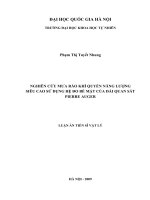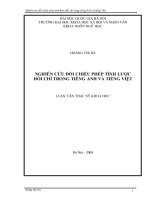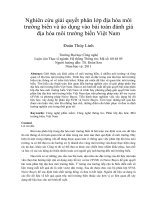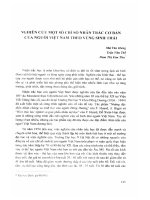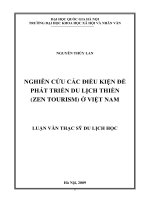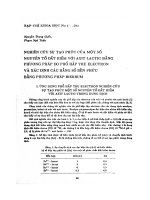DSpace at VNU: Nghiên cứu mưa rào khí quyển năng lượng siêu cao sử dụng hệ đo bề mặt của đài quan sát Piere Auger
Bạn đang xem bản rút gọn của tài liệu. Xem và tải ngay bản đầy đủ của tài liệu tại đây (227.47 KB, 15 trang )
ĐẠI HỌC QUỐC GIA HÀ NỘI
TRƯỜNG ĐẠI HỌC KHOA HỌC TỰ NHIÊN
Phạm Thị Tuyết Nhung
NGHIÊN CỨU MƯA RÀO KHÍ QUYỂN NĂNG LƯỢNG
SIÊU CAO SỬ DỤNG HỆ ĐO BỀ MẶT CỦA ĐÀI QUAN SÁT
PIERRE AUGER
LUẬN ÁN TIẾN SĨ VẬT LÝ
HÀ NỘI - 2009
ĐẠI HỌC QUỐC GIA HÀ NỘI
TRƯỜNG ĐẠI HỌC KHOA HỌC TỰ NHIÊN
Phạm Thị Tuyết Nhung
NGHIÊN CỨU MƯA RÀO KHÍ QUYỂN NĂNG LƯỢNG
SIÊU CAO SỬ DỤNG HỆ ĐO BỀ MẶT CỦA ĐÀI QUAN SÁT
PIERRE AUGER
Chuyên ngành: Vật lý hạt nhân nguyên tử
Mã số
: 62.44.05.01
LUẬN ÁN TIẾN SĨ VẬT LÝ
Người hướng dẫn khoa học:
1. DARRIULAT Pierre, Viện Khoa học Kỹ thuật Hạt nhân, Hà Nội
2. BILLOIR Pierre, LPNHE, Đại học Paris VI-UPMC
HÀ NỘI - 2009
UNIVERSITE PARIS VI – PIERRE ET MARIE CURIE
ECOLE DOCTORALE DE PHYSIQUE
La Physique de la particule à la matière condensée (ED389)
Doctorat de Physique
PHAM Thi Tuyet Nhung
Contribution à l’étude des grandes gerbes à l’aide du
détecteur de surface de l’Observatoire Pierre Auger
Thèse dirigée par
BILLOIR Pierre, LPNHE, Université Paris VI-UPMC
et
DARRIULAT Pierre, Institut des Sciences et Technologies Nucléaires, Hanoi
Soutenue le 18 décembre 2009
Soutenue devant la commission d'examen composée de:
TRAN Minh Tam
De KERRET Hervé
NGUYEN Mau Chung
BILLOIR Pierre
URBAN Marcel
Président
Rappoteur
Rappoteur
Directeur de thèse
ii
ĐẠI HỌC QUỐC GIA HÀ NỘI
TRƯỜNG ĐẠI HỌC KHOA HỌC TỰ NHIÊN
PHAM Thi Tuyet Nhung
Nghiên cứu mưa rào khí quyển năng lượng siêu cao sử dụng
hệ đo bề mặt của Đài quan sát Pierre Auger
Người hướng dẫn khoa học:
DARRIULAT Pierre, Viện Khoa học Kỹ thuật Hạt nhân Hà Nội
và
BILLOIR Pierre, LPNHE, Đại học Paris VI-UPMC
Ngày bảo vệ luận án: 18/12/2009
Hội đồng chấm luận án:
TRAN Minh Tam
De KERRET Hervé
NGUYEN Mau Chung
BILLOIR Pierre
URBAN Marcel
Chủ tịch
Phản biện
Phản biện
Người hướng dẫn
iii
This thesis has been made under joint supervision of Professors Pierre
Billoir (LPNHE, Paris) and Pierre Darriulat (INST, Hanoi) following the
cooperation agreement on jointly supervision PhD. between the Université
Pierre et Marie Curie and the Hanoi University of Science.
Cette thèse a été réalisée sous la direction conjointe des professeurs
Pierre Billoir (LPNHE, Paris) et Pierre Darriulat (INST, Hanoi) en
application de la convention de thèse en cotutelle entre l’Université Pierre
et Marie Curie et l’Univesité Scientifique de Hanoi.
Luận án này được thực hiện dưới sự đồng hướng dẫn của GS Pierre
Billoir (LPNHE, Paris) và GS Pierre Darriulat (INST, Hà Nội) theo văn bản
hợp tác đồng hướng dẫn nghiên cứu sinh giữa trường Đại học Pierre và
Marie Curie với trường Đại học Khoa học Tự nhiên Hà Nội.
iv
Acknowledgement
This thesis was made under joint supervision by Pr Pierre Billoir and Pr Pierre Darriulat,
both of whom I express my deepest gratitude for their constant support and invaluable
guidance. In particular, I am very grateful to Pr Pierre Billoir for having made my stays in
Paris both efficient and enjoyable and for his kindness and patience in giving me
suggestions, explanations and advice. I also express my deepest gratitude to Pr Pierre
Darriulat, for his invaluable guidance and his enthusiasm that makes his students like
science and motivates them to pursue research.
I thank my colleagues in the Pierre Auger Collaboration for their understanding and
constant support, in particular the members of the Auger groups in LPNHE, IPN/Orsay and
LAL.
I acknowledge the help and support of my professors in Hanoi University of Science, in
particular Pr Nguyen Mau Chung, Pr Pham Quoc Hung, Pr Dao Tien Khoa and Pr Bui Duy
Cam. Warm thanks are also expressed to my colleagues in the Institute for Nuclear Science
and Technology for their help and encouragement.
I warmly thank the members of the VATLY group for their friendly help, discussion
(fruitful or not) and kind friendship that makes the life in the lab so pleasant.
I also express my deepest gratitude to my family for their patience and moral support.
Finally, I acknowledge financial support from World Laboratory, French Ministère des
Affaires Étrangères (bourse Évariste Galois), Rencontres du Vietnam (bourse Odon
Vallet), French CNRS, Vietnam Atomic Energy Commission and Vietnam Ministry of
Science and Technology.
v
Résumé
Ce travail porte sur des observations réalisées à l’aide du détecteur de surface (SD)
de l’Observatoire Pierre Auger qui étudie les rayons cosmiques d’énergies supérieures à 10
EeV. Il détecte les grandes gerbes produites dans leur interaction avec l’atmosphère au
moyen d’un réseau de 1600 compteurs Cherenkov (CC) qui couvre 3000 km2. Les données
ont la forme d’un enregistrement digital des temps d’arrivée et des amplitudes des signaux
enregistrés par les trois photomultiplicateurs (PMT) de chaque CC. La thèse comporte des
études de leurs propriétés, d’une asymétrie observée entre les trois PMT d’un même CC et
de la désintégration de muons stoppant dans les CC.
En ce qui concerne la première, les incertitudes qui affectent la mesure ont été
évaluées et les différences observées entre les trois PMT d’un même CC ont été identifiées
et attribuées à deux causes bien maîtrisées : impulsions retardées et asymétrie de première
lumière. Un algorithme de recherche de pics, basé sur la déconvolution de la décroissance
exponentielle de la lumière détectée, a été affiné, sa performance évaluée et ses limites
identifiées, ouvrant ainsi la voie à son utilisation systématique dans des études ultérieures.
Une corrélation entre l’azimuth de la gerbe et l’asymétrie entre les trois PMT d’un
même CC, observée avant que la lumière n’ait le temps d’être suffisamment diffusée par
les parois, a été mise en évidence et exploitée pour mesurer la divergence de la gerbe et
illustrer la puissance de la méthode et sa sensibilité.
Enfin, on a mis en évidence l’existence de muons stoppant à l’intérieur du volume
des CC, identifiés par le signal produit par l’électron de désintégration. La difficulté de
cette étude réside dans la petitesse des signaux recherchés et permet de mettre à l’épreuve
la connaissance qu’on a du détecteur et des outils utilisés pour son analyse. Un bruit de
fond de très faible amplitude a été décelé, suggérant la présence vraisemblable de neutrons,
une possibilité qui reste à explorer.
vi
Tóm tắt
Luận án trình bày nghiên cứu sử dụng số liệu của hệ đo bề mặt (SD), Đài quan sát
Pierre Auger. Đài quan sát này ghi nhận mưa rào khí quyển diện rộng sinh ra do tia vũ trụ
siêu năng lượng cao (trên 10 EeV) tương tác với bầu khí quyển. Hệ SD gồm 1600 bình đo
Cherenkov nước trải rộng trên diện tích 3000 km2. Với mỗi bình đo, thông tin về thời gian
và độ lớn tín hiệu được ghi nhận bởi ba ống nhân quang điện (PMT) và được lưu dưới
dạng số. Luận án tập trung nghiên cứu đặc điểm của bình đo Cherenkov, tính bất đối xứng
tín hiệu giữa các PMT vào thời điểm xuất hiện tín hiệu và phân rã của muon ở trong bình
đo.
Nghiên cứu đầu tiên đã đánh giá những yếu tố bất định ảnh hưởng tới phép đo và
đưa ra bằng chứng cho thấy sự không đồng nhất xảy ra ở một số thời điểm giữa các PMT
của một bình đo là do hiện tượng sau xung và sự bất đối xứng tín hiệu lúc bắt đầu được ghi
nhận. Hai hiệu tượng này đều có thể kiểm soát được. Nghiên cứu đã phát triển thuật toán
xác định đỉnh tín hiệu dựa trên việc loại bỏ phần suy giảm theo hàm mũ của ánh sáng ghi
nhận bởi các PMT đồng thời đánh giá về khả năng cũng như hạn chế của nó, tạo tiền đề
cho việc áp dụng phương pháp một cách hệ thống trong các nghiên cứu sâu hơn.
Bất đối xứng tín hiệu xảy ra trước khi ánh sáng phân tán đều do khuếch tán nhiều
lần trên thành bình. Nghiên cứu cho thấy hiện tượng này có tương quan với góc tới của
trục mưa rào khí quyển và có thể sử dụng để xác định độ phân kỳ của mưa rào, chứng tỏ
khả năng và minh họa cho độ nhạy của phương pháp.
Nghiên cứu phân rã muon trong bình đo dựa vào việc xác định tín hiệu của sản
phẩm phân rã là electron. Nghiên cứu này đã giải quyết một số khó khăn gây ra do biên độ
tín hiệu của electron rất nhỏ, cung cấp thêm một phép đánh giá khả năng hoạt động của
bình đo cũng như phương pháp phân tích tín hiệu. Nghiên cứu cũng cho thấy tồn tại một
phông nền thấp có thể gây ra bởi các neutron, điều này cần được làm rõ bằng các nghiên
cứu sâu hơn.
vii
Contribution to the study of ultra high energy showers
using the surface detector of the Pierre Auger Observatory
Summary
The present thesis deals with observations made using the surface detector (SD) of
the Pierre Auger Observatory that studies cosmic rays having energies in excess of 10
EeV. It detects the extensive air showers produced by such cosmic rays in their interactions
with the atmosphere in an array of 1600 water Cherenkov counters (CC) that covers 3000
km2. The information available from the SD is in the form of digitized records of the time
of arrival and amplitude of the signals recorded in each CC by three photomultiplier tubes
(PMT). The thesis includes studies of their properties, of the early time PMT asymmetry
and of the decay of muons stopping in the counters.
Concerning the former, the uncertainties affecting the measurement have been
evaluated and evidence has been given that the occasional apparent inconsistencies
between the three PMTs of a same CC reduce to only two types, after pulses and early time
asymmetries, both of which are under control. A peak finding algorithm consisting in
unfolding the exponential decay of the collected light has been refined, its performance has
been assessed and its limitations have been identified, opening the road toward its
systematic use in further studies.
A PMT asymmetry, occurring before the light has a chance of being randomized
by multiple diffusions on the CC walls, has been shown to be correlated with the azimuth
of the shower axis, which has been exploited to evaluate the shower divergence, to show
the power of the method and illustrate its sensitivity.
Finally, a search for muons stopping in the water volume of the CCs, identified by
the signal produced by the decay electron, has overcome the difficulties resulting from
their small amplitude and has given an opportunity to assess the detector performance,
providing a test of both the detector and the tools available for its analysis. Evidence has
been found for a very low charge background that might be associated with neutrons, a
possibility that remains to be explored.
viii
Mot-clé: rayons cosmiques d' énergies extrêmes
Từ khóa: tia vũ trụ năng lượng cao
Keyword: ultra high energy cosmic rays
ix
References
[1] Th. Wulf, Phys. Zeitschr. 10 (1909) 152.
[2] V.F. Hess, Z. Phys. 13 (1912) 1084.
[3] J. Clay, Proc. Roy. Acad, Amsterdam 30 (1927) 1115.
[4] P. Auger, P. Ehrenfest, R. Maze, J. Daudin and A.F. Robley, Rev. Mod. Phys. 11
(1939) 288;
P. Auger, R. Maze and T. Grivet-Mayer, Académie des sciences, Paris, 206 (1938) 1721
[5] C.D. Anderson, Science 76 238 (1932); Phys. Rev. 43 (1933) 491.
[6] S.H. Neddermeyer and C.D. Anderson, Phys. Rev. 51 (1937) 884;
J.C. Street and E.C. Stevenson, Phys. Rev. 52 (1937) 1003.
[7] C.M.G. Lattes, H. Muirhead, G.P.S. Occhialini, and C.F. Powell, Nature 159 (1947)
694;
C.M.G. Lattes, G.P.S. Occhialini, and C.F. Powell, Nature 160 (1947) 486; Nature 160
(1947) 453.
[8] P. Bhattacharjee and G. Sigl, Phys. Rept. 327 (2000) 109–247.
[9] J. Linsley, L. Scarsi, and B. Rossi, Phys. Rev. Lett. 6 (1961) 485;
J. Linsley, Phys. Rev. 97 (1955) 1292.
[10] J.W. Cronin, Rev. Mod. Phys. 71 (1999) S165;
M. Nagano and A.A. Watson, Rev. Mod. Phys. 72 (2000) 689.
[11] R. Cornils et al., APh 20 (2003) 129;
K. Bernlohr et al., APh 20 (2003) 111.
[12] M. C. Weisskopf, H. D. Tananbaum, L. P. Van Speybroeck and S. L. O'Dell, Proc.
SPIE 4012, 2000, arXiv:astro-ph/0004127v1.
[13] F.A. Aharonian et al., Nature 432 (2004) 75;
F.A. Aharonian et al. (H.E.S.S. Col laboration) A&A 449 (2006) 223.
[14] E. Fermi, Phys. Rev. 75, 1169 (1949)
[15] L.O’C. Drury, Rep. Prog. Phys. 46 (1983) 973;
R.D. Blandford and D. Eichler, Phys. Rept. 154 (1987) 1;
F.C. Jones and D.C. Ellison, Sp. Sc. Rev. 58 (1991) 259;
L.O’C. Drury, Contemp. Phys., 35 (1994) 232.
[16] Y. Uchiyama et al., Nature 449 (2007) 576.
[17] E.G. Berezhko and H.J. Völk, A&A 419 (2004) L27.
[18] K. Greisen, Proc. 9th ICRC, 2 (1965) 609.
[19] A.M. Hillas, Ann. Rev. Astron. Astrophys., 22 (1984) 425.
[20] R.A. Dupke, N. Mirabal, J.N. Bregman and A.E. Evrard, ApJ 668 (2007) 781;
135
N.T. Huong, Galaxy collisions as possible sources of ultrahigh energy cosmic rays,
dissertation at the Hanoi University of Education, 2008.
[21] The Pierre Auger Project Design Report, The Auger Collaboration, 2nd Edition,
Fermi Laboratory, November 1996, Revised March 1997.
/>[22] J. Abraham et al., Nucl. Instrum. Meth. A523 (2004) 50.
[23] R. Engel, presented at 40th Rencontres de Moriond, Italy (2005).
[24] A.M. Hillas, Proc. 17th ICRC, 8 (1981) 193.
[25] B. Dawson [Pierre Auger Collaboration], Proc. 30th ICRC, Merida, (2007) #0976,
arXiv:astro-ph/0706.1105.
[26] D. Bird et al., Nucl. Inst. Meth., A349 (1994) 592;
D. Bird et al., Astrophys. J. 424 (1994) 491.
[27] T.K. Gaisser and A.M. Hillas, Proc. 15th ICRC, 8 (1977) 353.
[28] J. Linsley and L. Scarsi, Phys. Rev. 128 (1962) 2384;
J. Linsley, L. Scarsi and B. Rossi, Phys. Rev. Lett. 6 (1961) 458.
[29] M. Ave [Pierre Auger Collaboration], Proc. 30th ICRC, 4 (2007) 307.
[30] A.K. Tripathi, Nucl. Instr. and Meth. A 504 (2003) 1;
P. Ranin et al., UCLA-Cosmic/2001-02;
A. Tripathi et al., UCLA-Cosmic/2001-02 and GAP 2002-013.
[31] S. Agostinelli et al., Nucl. Instrum. Meth. A506 (2003) 250;
J. Allison et al., IEEE Trans. Nucl. Sci. 53 (2006) 270.
[32] C. Pryke, GAP 1996-008;
C. Pryke, Auger internal GAP 1997-004;
T. McCauley and T. Paul, GAP 2000-055;
W.E. Slater, A. Tripathi and K. Arisaka, GAP 2002-063;
T. Ohnuki, G. Rodriguez-Fernandez, D. Barnhill, A. Tripathi, T. McCauley and
T.K. Arisaka, GAP-2004-043;
M. Zha and J. Knapp, GAP 2005-031;
A. Creusot and D. Veberic, GAP 2007-073.
[33] N. Kalmykov, S. Ostapchenko and A. Pavlov, Nucl. Phys. Proc. Suppl. B52 (1997)17;
S. Ostapchenko, Phys. Rev. D74 (2006) 014026;
S. Ostapchenko, Nucl. Phys. Proc. Suppl. 151 (2006) 143;
S. Ostapchenko, Phys. Lett. B636 (2006) 40;
G. Battistoni et al., AIP Conf. Proc. 896 (2007) 31.
[34] R. Engel, T. Gaisser, T. Stanev, and P. Lipari, Proc. 26th ICRC, 1 (1999) 415;
R. Fletcher, T. Gaisser, P. Lipari, and T. Stanev, Phys. Rev. D50 (1994) 5710;
136
K. Werner and T. Pierog, AIP Conf. Proc. 928, 111 (2007), arXiv:0707.3330.
[35] D. Heck, J. Knapp, J. Capdevielle, G. Schatz, and T. Thouw, FZKA-6019 (1998).
[36] S. Sciutto, AIRES. />[37] K. Greisen, Phys. Rev. Lett. 16 (1966) 748;
G. Zatsepin and V. Kuzmin, JETP Lett. 4 (1966) 78.
[38] F. Shussler [Pierre Auger Collaboration], Proc. 31th ICRC, Lodz, Poland, 2009.
[39] R. U. Abbasi et al. Phys. Rev. Lett., 100 (2008) 101101;
R. U. Abbasi et al. Phys. Lett., B619 (2005) 271.
[40] J. Abraham et al. [Pierre Auger Collaboration], Astropart. Phys. 29 (2008) 188;
J. Abraham et al. [Pierre Auger Collaboration], Science 318. no. 5852 (2007) 938.
[41] J.D. Hague, [Pierre Auger Collaboration], Proc. 31th ICRC, Lodz, Poland, 2009.
[42] M.P. Veron-Cetty and P. Veron, Astron. Astrophys. 455 (2006) 773.
[43] D. De Marco and T. Stanev, Phys. Rev. D72 (2005) 081301;
T. Wibig and A. W. Wolfendale, J. Phys. G31 (2005) 255.
[44] D. Allard, E. Parizot, and A. Olinto, Astropart. Phys. 27 (2007) 61, astro-ph/0512345.
[45] V. Berezinsky, S. Grigoreva, and B. Hnatyk, Nucl. Phys. Proc. Suppl. 151 (2006) 497.
[46] R.J. Glauber and G. Matthiae, Nucl. Phys. B21 (1970) 135;
K.G. Boreskov and A.B. Kaidalov, Sov. J. Nucl. Phys. 48 (1988) 367.
[47] T.K. Gaisser et al., Proc. 16th ICRC 9 (1979) 258;
T.K. Gaisser et al., Phys. Rev. D47 (1993) 1919;
J. Linsley and A.A. Watson, Phys. Rev. Lett. 46 (1981) 459;
J. Matthews, Astropart. Phys. 22 (2005) 387;
W. Heitler, “The Quantum Theory of Radiation“, Oxford University Press, 1954.
[48] C. Bonifazi et al. [Pierre Auger Collaboration], Nucl. Phys. Proc. Suppl. 190 (2009)
20, arXiv:0901.3138.
[49] M. Unger et al., Nucl. Instrum. Meth. A 588 (2008) 433.
[50] M. Unger et al. [Pierre Auger Collaboration], in preparation (2009).
[51] T. Bergmann et al., Astropart. Phys. 26 (2007) 420.
[52] R. Walker & A.A. Watson, J. Phys. G7 (1981) 1279.
[53] D. Newton et al., Astropart. Phys. 26 (2007) 414.
[54] H. Wahlberg [Pierre Auger Collaboration], Proc. 31th ICRC, Lodz, Poland, 2009.
[55] X. Bertou and P. Biloir, GAP 2000-017;
X. Bertou, P.D. Silva and P. Biloir, GAP 2002-074;
[56] M. Healy [Pierre Auger Collaboration], Proc. 30th ICRC, 4 (2007) 377.
[57] F. Schmidt et al., Astropart. Phys. 29 (2008) 355.
137
[58] A. Castellina [Pierre Auger Collaboration], Proc. 31th ICRC, Lodz, Poland, 2009.
[59] P.N. Diep, VATLY internal note nr 33, "More on the jump method", August, 2009.
[60] B. Genolini et al., GAP 2001-021 and 2003-051;
G. Navarra, GAP 2005-006.
[61] P.S. Allison and D. Barnhill, GAP 2004-046.
[62] A. Creusot et al., GAP 2002-042.
[63] M. Aglietta, GAP 2005-010.
[64] P.N. Dong and P.T. Nhung, VATLY internal note nr 31, The PMTs of the PAO
surface detector: New measurements, August 2009 and GAP 2009-115.
[65] Burle Photomultiplier Handbook (TP-136), Lancaster, PA (1989);
S. Atulugama and S.Coutu, GAP 2005-100 and references therein.
[66] A. Lopez-Agüera, V. M. Olmos-Gilbaja and G. Rodriguez Fernandez, GAP 2003-112,
GAP 2004-026 and GAP 2004-061.
[67] P. Billoir, GAP 2002-076 and GAP 2005-074.
[68] P.T. Nhung, Reducing FADC traces to a sum of peaks, VATLY internal note 15,
August 2005.
[69] B. Smith, C. Wileman and A. Watson, GAP 2007-092 and references therein.
[70] M. Urban et al, GAP 2007-020;
[71] P.N.Diep, GAP 2008-136;
P.N. Diep, More on the jump method, VATLY internal note nr 27, September 2008.
[72] Aaron Chou, GAP 2004-057.
[73] J. Cronin, GAP 2003-076.
[74] J. Abraham et al., Nuc. Inst. Meth. A523 (2004) 50.
[75] D. T. The, graduation thesis, 2007, Hanoi University of Education.
[76] P.T. Nhung and P. Darriulat, Spikes in the raw FADC traces, VATLY internal notes
17, November 2006 and 17add., December 2006.
[77] P.T. Nhung and P. Darriulat, Using the asymmetry information to help the reduction
of FADC traces into peaks: a first look, VATLY internal note 19, February 2007;
P.T. Nhung and P.Billoir, GAP 2007-131.
[78] P.N. Dong and N.T. Thao, VATLY internal note nr 24, A VATLY test bench for the
study of XP1805 photomultiplier tubes, and note nr 24 add, 2008.
[79] A. Tripathi et al., GAP 2002-013.
[80] M. Unger et al., Proc. 30th ICRC, Merida, Mexico (2007).
[81] P. Billoir, private communication.
138
[82] X. Garrido et al., GAP 2007-060 and 2009-023.
[83] D.E. Groom et al., Eur. Phys. J. C15 (2000) 1.
[84] T. Suzuki, Phys Rev C35 (1987) 2212.
[85] D. Newton et al., Astropart. Phys. 26 (2007) 414.
[86] The event selection group, GAP 2005-023.
[87] P. Billoir, GAP 2000-025.
[88] P.T. Nhung, VATLY internal note nr 16 add. (2006), nr 22 (2008) and nr 26 (2009).
[89] F.Arneodo et al., in preparation (2009);
F. Arneodo [Pierre Auger Collaboration], Proc. 29th ICRC 8 (2005) 299.
139
